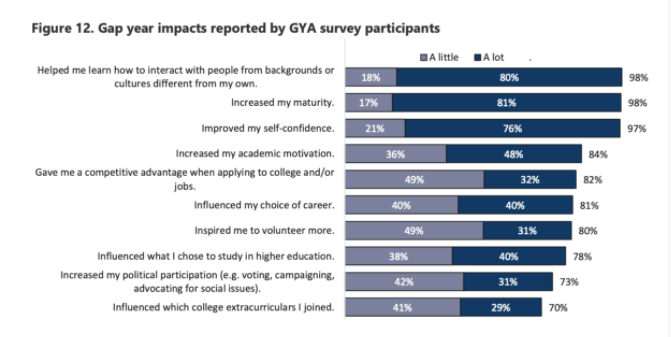Destigmatizing gap years
Breaking down the facts about taking a year off after high school
High school seniors are faced with possibly the single biggest decision in their lives before many of them can even vote. While so many Americans are quick to judge students for taking a year off between high school and college, they don’t think twice about them signing up for thousands of dollars of debt without a full understanding of why.
In this country, gap years are seen as an excuse to never go to college and are often viewed as lazy, therefore shaming those who take them. However, in many European countries they are completely normal and appreciated.
This difference in interpretation comes from the classic American beliefs that hard work breeds success, and as a result, taking time away from the big wheel of Capitalism is terrible.
Regardless of this difference in belief, there is far more validity in the European perspective than the American. A survey done by the GYA Research Committee shows that 88% of gap year graduates report their gap year added to their employability making them better members of the workforce.
A common misconception about gap years is that they are an excuse to skip college and throw away career goals. However, according to the Wall Street Journal, 90% of those who take a gap year return to college which disproves this theory.
The year away from school serves many purposes. Gap years are a good time for some students to work and save up money for college so they are not plagued with debt once they graduate. It is also an opportunity for students to learn more about their passions and goals, as well as prevent burnout so when they do go to college they are more appreciative and get the most out of their experience.
In a 2015 survey the American Gap Association found that 98% of students who took a gap year reported it helped them grow as a person, and one in two of the responses reported they took a gap year to explore academic options and volunteerism.
One main systemic issue in the U.S. regarding the gap year is the lack of deferral programs which are prominent in European education systems. Programs similar to the Florida State University deferral program allow students who defer to receive financial aid for their projected activities such as service projects or study abroad. These deferral programs offer students the reassurance that they will be allowed to return to college when their year is over and allow them more opportunities to be productive in their gap year.
The UK Department of Education and Skills estimated between 200,000 and 250,000 of the 1.8 million undergrad students in the UK took a gap year in 2019. In comparison, only 40,000 out of 2 million US students took a gap year in 2019. This difference in participation stems from differences in societal values, available programs, and stigmas around gap years in the US that shame and devalue those who wish to partake in a year off to explore their options.


Aubrey is a senior in her third year in journalism. In her spare time she enjoys jewelry making, over sharing on the internet, reading non-fiction, and...

